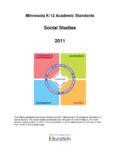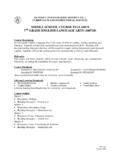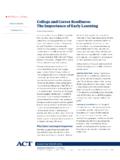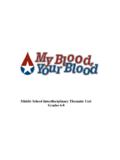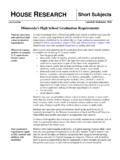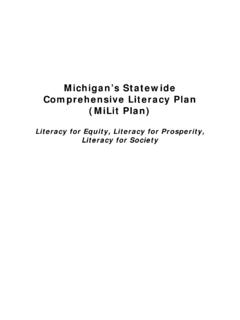Transcription of Minnesota K-12 Academic Standards in - Social …
1 Minnesota Academic Standards English language arts K-12 2010 This official Standards document contains the English language arts Standards revised in 2010 and adopted into rule effective Nov. 29, Table of Contents Introduction .. 4 Standards for English language arts & Literacy in History/ Social Studies, Science, and Technical Subjects K 5 .. 12 College and Career Readiness Anchor Standards for 13 Reading Standards for Literature K 5 .. 14 Reading Standards for Informational Text K 5 .. 18 Reading Standards : Foundational Skills K 5 .. 22 College and Career Readiness Anchor Standards for Writing .. 25 Writing Standards K 5 .. 26 College and Career Readiness Anchor Standards for Speaking, Viewing, Listening and Media Literacy .. 31 Speaking, Viewing, Listening and Media Literacy Standards K 5 .. 32 College and Career Readiness Anchor Standards for language .
2 37 language Standards K 5 .. 38 language Progressive Skills, by Grade .. 44 Standard 10: Range, Quality, and Complexity of Student Reading K 5 .. 45 Staying on Topic Within a Grade and Across Grades .. 47 Standards for English language arts 6 12 .. 48 College and Career Readiness Anchor Standards for Reading .. 49 Reading Standards for Literature 6 12 .. 50 Reading Standards for Informational Text 6 12 .. 54 College and Career Readiness Anchor Standards for Writing .. 58 Writing Standards 6 12 .. 59 College and Career Readiness Anchor Standards for Speaking, Viewing, Listening and Media Literacy .. 66 Speaking, Viewing, Listening and Media Literacy Standards 6 12 .. 67 College and Career Readiness Anchor Standards for language .. 72 language Standards 6 12 .. 73 language Progressive Skills, by Grade .. 77 Standard 10: Range, Quality, and Complexity of Student Reading 6 12.
3 78 Standards for Literacy in History/ Social Studies, Science, and Technical Subjects .. 80 College and Career Readiness Anchor Standards for Reading .. 81 Reading Standards for Literacy in History/ Social Studies 6 12 .. 82 Reading Standards for Literacy in Science and Technical Subjects 6 12 .. 84 College and Career Readiness Anchor Standards for Writing .. 86 Writing Standards for Literacy in History/ Social Studies, Science, and Technical Subjects 6 12 .. 87 Note: This document in its entirety constitutes the complete 2010 Minnesota Academic Standards in English language arts K-12. It consists of the Common Core State Standards (shown in plain font) plus Minnesota s additions (shown in bold font). 3 4 Introduction The Common Core State Standards for English language arts & Literacy in History/ Social Studies, Science, and Technical Subjects ( the Standards ) are the culmination of an extended, broad-based effort to fulfill the charge issued by the states to create the next generation of K 12 Standards in order to help ensure that all students are college and career ready in literacy no later than the end of high school.
4 The present work, led by the Council of Chief State School Officers (CCSSO) and the National Governors Association (NGA), builds on the foundation laid by states in their decades-long work on crafting high-quality education Standards . The Standards also draw on the most important international models as well as research and input from numerous sources, including state departments of education, scholars, assessment developers, professional organizations, educators from kindergarten through college, and parents, students, and other members of the public. In their design and content, refined through successive drafts and numerous rounds of feedback, the Standards represent a synthesis of the best elements of Standards -related work to date and an important advance over that previous work. As specified by CCSSO and NGA, the Standards are (1) research and evidence based, (2) aligned with college and work expectations, (3) rigorous, and (4) internationally benchmarked.
5 A particular standard was included in the document only when the best available evidence indicated that its mastery was essential for college and career readiness in a twenty-first-century, globally competitive society. The Standards are intended to be a living work: as new and better evidence emerges, the Standards will be revised accordingly. The Standards are an extension of a prior initiative led by CCSSO and NGA to develop College and Career Readiness (CCR) Standards in reading, writing, speaking, listening, and language as well as in mathematics. The CCR Reading, Writing, and Speaking and Listening Standards , released in draft form in September 2009, serve, in revised form, as the backbone for the present document. Grade-specific K 12 Standards in reading, writing, speaking, listening, and language translate the broad (and, for the earliest grades, seemingly distant) aims of the CCR Standards into age- and attainment-appropriate terms.
6 (Note: In Minnesota , the K-12 Standards address viewing and media literacy, in addition to the Standards in reading, writing, speaking, listening, and language .) The Standards set requirements not only for English language arts (ELA) but also for literacy in history/ Social studies, science, and technical subjects. Just as students must learn to read, write, speak, listen, and use language effectively in a variety of content areas, so too must the Standards specify the literacy skills and understandings required for college and career readiness in multiple disciplines. Literacy Standards for grade 6 and above are predicated on teachers of ELA, history/ Social studies, science, and technical subjects using their content area expertise to help students meet the particular challenges of reading, writing, speaking, listening, and language in their respective fields.
7 It is important to note that the 6 12 literacy Standards in history/ Social studies, science, and technical subjects are not meant to replace content Standards in those areas but rather to supplement them. States may incorporate these Standards into their Standards for those subjects or adopt them as content area literacy Standards . As a natural outgrowth of meeting the charge to define college and career readiness, the Standards also lay out a vision of what it means to be a literate person in the twenty-first century. Indeed, the skills and understandings students are expected to demonstrate have wide applicability outside the classroom or workplace. Students who meet the Standards readily undertake the close, attentive reading that is at the heart of understanding and enjoying complex works of literature. They habitually perform the critical reading necessary to pick carefully through the staggering amount of information available today in print and digitally.
8 They actively seek the wide, deep, and thoughtful engagement with high-quality literary and informational texts that builds knowledge, enlarges experience, and broadens worldviews. They reflexively demonstrate the cogent reasoning and use of evidence that is essential to both private deliberation and responsible citizenship in a democratic republic. In short, students who meet the Standards develop the skills in reading, writing, speaking, and listening that are the foundation for any creative and purposeful expression in language . Common Core State Standards Initiative, June 2, 2010 5 Minnesota and the Common Core State Standards Minnesota actively participated in the development of the Common Core Note: SState Standards for English language arts & Literacy in History/ Social of standa Studies, Science, and Technical Subjects. Beginning with the draft College notes in tand Career Readiness (CCR) Standards in the summer of 2009, the Minnesot a Reading materialsDepartment of Education convened a series of educator focus groups.
9 The groups provided detailed feedback on the CCR Standards and each successi ve draft of the K-12 Standards until they were completed in June 2010. Many of the suggestions provided by Minnesota educators were incorporated into the Common Core Standards . Overall, there is strong alignment between the Common Core and Minnesota s K-12 Academic Standards in language arts (2003), and the Minnesota College and Work Readiness Expectations language arts (2008). During the summer of 2010, Minnesota s Standards Committee revised the state s 2003 language arts Standards , as required by law (Minn. Stat. , Subd. 2). Given the strong alignment between the Common Core and Minnesota documents, the state decided, as part of the revision, to adopt the Common Core Standards as a basis for the Minnesota Academic Standards -English language arts K-12. States that choose the Common Core are required to adopt 100 percent of the Common Core K-12 Standards (word for word), with the option of adding up to 15 percent additional content.
10 Minnesota s Standards Committee analyzed the Common Core Standards and identified additional knowledge and skills in order to address particular legislative requirements and better reflect research and evidence-based best practices in English language arts . The resulting document is the 2010 Minnesota Academic Standards English language arts K-12. Students must satisfactorily complete these Standards beginning in the 2012-2013 school year. The Common Core built on the foundation laid by states in their decades-long work on crafting Standards . Minnesota , in turn, built on the work of the Common Core by adding critical knowledge and skills deemed important for higher education and work in the twenty-first century global economy. Given this strong foundation of Standards , Minnesota students will be well-equipped with the literacy skills needed for success in college, careers and active participation in civic life.
